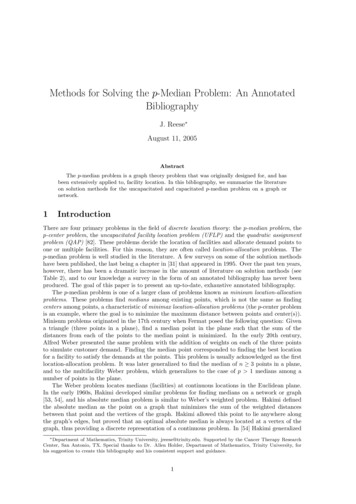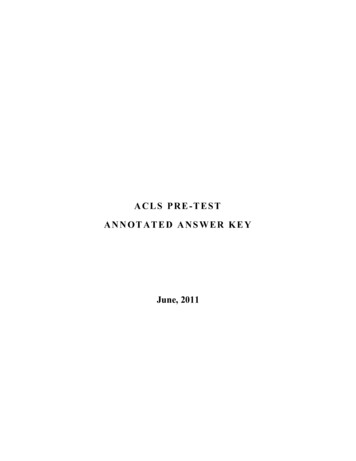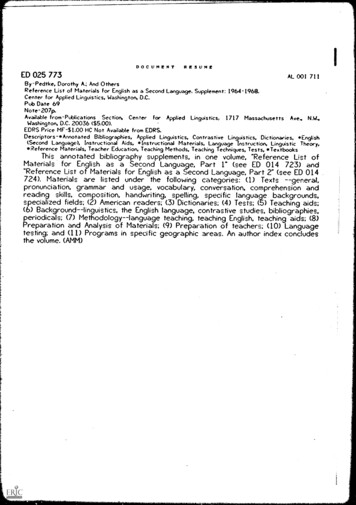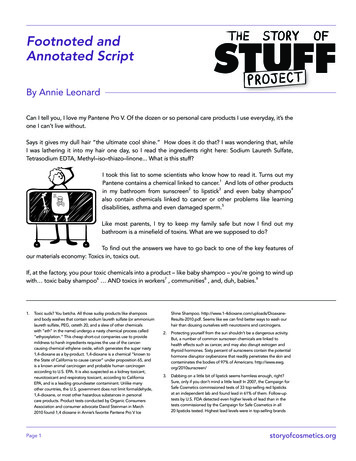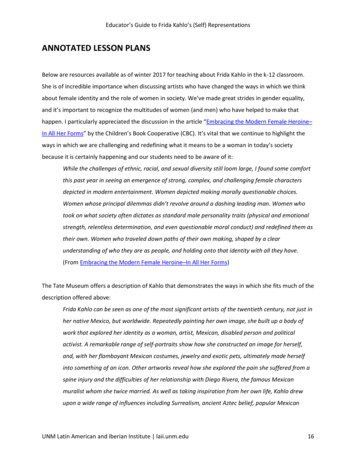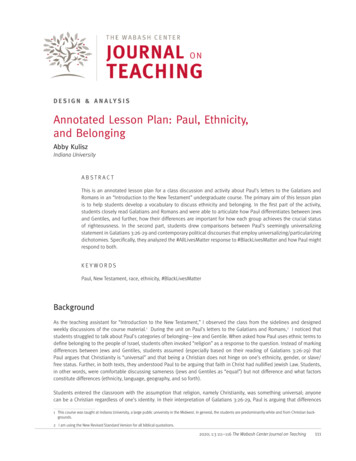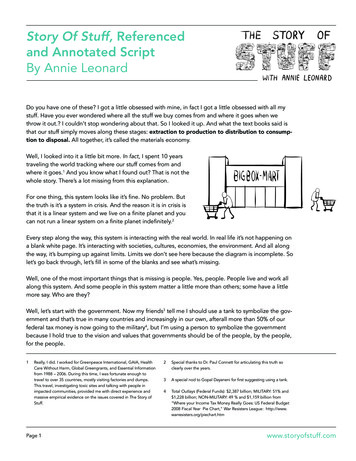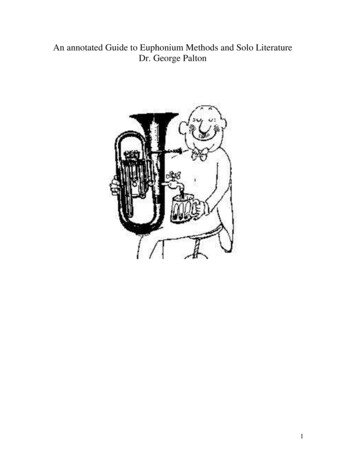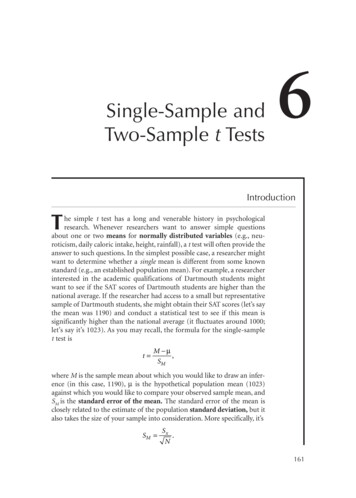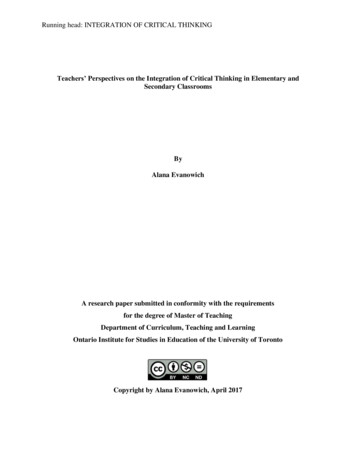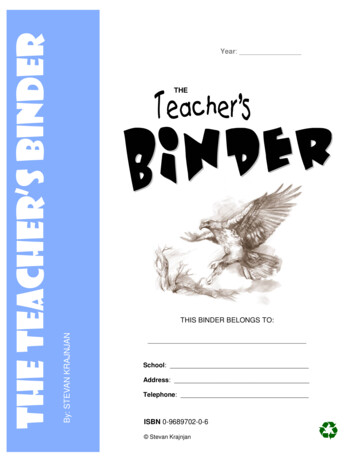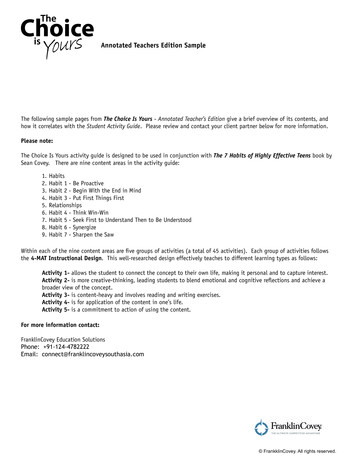
Transcription
Annotated Teachers Edition SampleThe following sample pages from The Choice Is Yours - Annotated Teacher’s Edition give a brief overview of its contents, andhow it correlates with the Student Activity Guide. Please review and contact your client partner below for more information.Please note:The Choice Is Yours activity guide is designed to be used in conjunction with The 7 Habits of Highly Effective Teens book bySean Covey. There are nine content areas in the activity guide:1.2.3.4.5.6.7.8.9.HabitsHabit 1 - Be ProactiveHabit 2 - Begin With the End in MindHabit 3 - Put First Things FirstRelationshipsHabit 4 - Think Win-WinHabit 5 - Seek First to Understand Then to Be UnderstoodHabit 6 - SynergizeHabit 7 - Sharpen the SawWithin each of the nine content areas are five groups of activities (a total of 45 activities). Each group of activities followsthe 4-MAT Instructional Design. This well-researched design effectively teaches to different learning types as follows:Activity 1- allows the student to connect the concept to their own life, making it personal and to capture interest.Activity 2- is more creative-thinking, leading students to blend emotional and cognitive reflections and achieve abroader view of the concept.Activity 3- is content-heavy and involves reading and writing exercises.Activity 4- is for application of the content in one’s life.Activity 5- is a commitment to action of using the content.For more information contact:FranklinCovey Education SolutionsPhone: 91-124-4782222Email: connect@franklincoveysouthasia.com FrankklinCovey. All rights reserved.
AnnotatedsrehcaTenoitidEEducation Solutions’
Table ntseof ContWelcome . 1Introduction . 2Get in the Habit. 5Habit 1: Be Proactive . 13Habit 2: Begin With the End in Mind . 19Habit 3: Put First Things First. 25The Relationship Bank Account . 33Habit 4: Think Win-Win . 39Habit 5: Seek First to Understand, Then to Be Understood . 47Habit 6: Synergize . 53Habit 7: Sharpen the Saw. 59A Personality Exercise . 67Assessment and LearningPre-Test / Post-Test . 72Learning Checklist . 74Put Your School on the Path of Greatness . 75 FranklinCovey. All rights reserved, including the right of reproduction in whole or in part in any form.This book is the proprietary work of FranklinCovey. “The 7 Habits” and many other terms, slogans, and logos found in this book arecopyrights, trademarks, or service marks of FranklinCovey. Any unauthorized use of this copyrighted material or use of any of theseterms, slogans, and logos without express prior written permission of FranklinCovey’s is prohibited.Designed and illustrated by The FaQtory.MANUFACTURED IN THE UNITED STATES OF AMERICA.
Annotated Teacher’s EditionWelcomeWelcomeWelcome to the Annotated Teacher’s Edition of The Choice Is Yours Activity Guide.This program was created to introduce middle-school students to the principlesin The 7 Habits of Highly Effective Teens by Sean Covey.The Choice Is Yours is designed to help your students succeed both in and out ofthe classroom. These 5-minute activities will help students reflect on their lives,develop leadership skills, and set goals that will inspire them to succeed. Thisactivity guide can be a wonderful tool for any teacher and a powerful motivatorfor any student.Using the AnnotatedTeacher’s EditionWe’ve designed the Annotated Teacher’s Edition to requireminimal teacher involvement and to provide several waysto enhance the learning experience for the students.The annotations allow for optional classroomdiscussions and variations to each activity, if yourclassroom time permits. We’ve also includedpre- and post-assessments and additional readingsfor interested students.The lessons in this activity guide are flexible. Theactivities don’t have to be completed daily. Activities canbe assigned biweekly or weekly according to the availabletime in your classroom.Assessment andLearning ChecklistWe’ve provided The Choice Is Yours Pre-Test/Post-Test andLearning Checklist at the end of the Annotated Teacher’s Editionto help you gauge your students’ understanding of The 7 Habitsof Highly Effective Teens.You may copy and distribute these questionnaires to your students,or use them as templates and revise them as you see fit. FranklinCovey. All rights reserved, including the right of reproduction in whole or part in any form.1
Habit 1 s Be ProactiveAnnotated Teacher’s Edition!#4)6)49 ss 0!'%!#4)6)490!'% Choose How to RespondKey ConceptYou are responsible for yourchoices.ACTIVITY 1Choose HowtoRespondHow do you react when someone cuts in front of youin line? Do you yell at him, or just let it go? If you getin a argument with your best friend, do you tell her offand avoid her for months, or do you forgive her? About 100times a day, we get to choose how we respond to different situations.Discussion QuestionsThink of a time in your life whenyou were angriest. Why did youbecome so angry?Can we always choose how werespond to every situation? Whyor why not?How Would You React?Write how you would handle each of the following situations.1. While you and your little brother are home alone, he makes a mess and thenblames it on you.Additional ReadingPage 48 in the Teens book.2. While taking a test, you look at the person across from you, and he or she islooking at your paper.3. As you’re walking down the hall, you overhear a bunch of your friends talkingabout you behind your back.If time permits .Habit 1: Be Proactive – 13Have students turn to a partnerand act out the situations in theactivity. FranklinCovey. All rights reserved, including the right of reproduction in whole or part in any form.13
Annotated Teacher’s EditionHabit 1 s Be Proactive!#4)6)49 s 0!'% A Lesson From Soda PopKey ConceptACTIVITY 2You are responsible foryour choices.A LessonfromSoda PopWhat if one of your friends gave you acan of soda pop that he had been shakingfor the last 5 minutes? Would you wantto open the can?Discussion QuestionsWhat is it like being around aperson who reacts like a can ofshaken soda pop?Reactive behavior is just like a can of sodapop that explodes when the pressure builds.Proactive behavior means thinking beforeyou act and being cool and calm.How does it feel when you’rebeing reactive?Proactive and Reactive BehaviorWhat other things does reactive and proactivebehavior remind you of?Draw or write them below.Additional ReadingREACTIVE BEHAVIOR IS LIKE . . .Scenes One and Two on pages49–50 in the Teens book.Example: A volcanoIf time permits Ask for some volunteers toshare their answers or show thedrawings they did for the activity.Review Scenes One and Two onpages 49–50 in the Teens book.14 – Habit 1: Be Proactive FranklinCovey. All rights reserved, including the right of reproduction in whole or part in any form.14
Habit 1 s Be ProactiveAnnotated Teacher’s Edition!#4)6)49 s 0!'% A Lesson From Soda Pop (continued)PROACTIVE BEHAVIOR IS LIKE . . .Example: A bottle of waterHabit 1: Be Proactive – 15 FranklinCovey. All rights reserved, including the right of reproduction in whole or part in any form.15
Annotated Teacher’s EditionHabit 1 s Be Proactive!#4)6)49 s 0!'% Proactive and Reactive LanguageKey ConceptYou are responsible foryour choices.ACTIVITY 3ProactiveandReactive LanguageHow can you recognize reactive and proactive behavior?Discussion Questions(Use an example of reactivelanguage you hear regularly inthe classroom.)All you have to do is listen to the way someonetalks. Here’s how reactive people talk:“That’s me. That’s just the way I am.” What they’re reallysaying is, I’m not responsible for the way I act, and Ican’t change.Why is that an example ofreactive language?“Thanks a lot. You just ruined my day.” What they’rereally saying is, I’m not in control of my own moods;you are.How can using proactivelanguage help you in school, athome, and with your friends?Notice how reactive language takes the blame awayfrom the speaker and places it on someone else?Proactive behavior is always in control. Proactivepeople say things like, I choose to . . ., There’s gotta bea way, and I can do better than that.Say What?Additional ReadingPage 51 in the Teens book.The chart below is full of reactive statements. Next to eachreactive statement, write a corresponding proactive statement.PROACTIVE LANGUAGEREACTIVE LANGUAGEExample: I’ll do it.I’ll try.That’s just the way I am.There’s nothing I can do.I have to.If time permits Ask students to share some ofthe proactive statements theywrote for this activity.Write the students’ examples onthe board.I can’t.For more examples of reactive language, read page 51 in the Teens book.16 – Habit 1: Be Proactive FranklinCovey. All rights reserved, including the right of reproduction in whole or part in any form.16
Habit 1 s Be ProactiveAnnotated Teacher’s Edition!#4)6)49 s 0!'% A Can-Do AttitudeKey ConceptACTIVITY 4You are responsible foryour choices.A Can-DoAttitudeA can-do attitude is very important forgetting you to where you want to go in life.Can-do means that you make things happen; youdon’t wait around for something to happen to you. Ifyou want to make the basketball team, you practiceevery day. If you want to have more friends, you findways to meet new people.Remember, can-do is not pushy and annoying.Can-do people are persistent and motivated. Theyknow what they want out of life, and they work hard to get it.Discussion QuestionsWhat does it mean to bepersistent and motivated?Can you think of a time whenyou had a can-do attitude?Can you think of a time whenyou wished you had a can-doattitude?The Sky Is the LimitIf you want to make a sports team or get good grades, you needa can-do attitude. Use the space below to draw a picture or writeabout some of the things you want to accomplish this year.Additional Reading
This book is the proprietary work of FranklinCovey. “The 7 Habits” and many other terms, slogans, and logos found in this book are copyrights, trademarks, or service marks of FranklinCovey. Any unauthorized use of this copyrighted material or use of any of these terms, slogans, and logos without express prior written permission of FranklinCovey’s is prohibited. Designed and illustrated .
